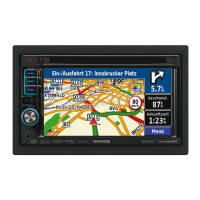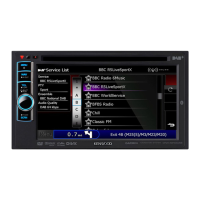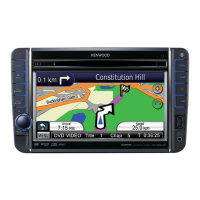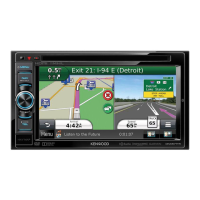Do you have a question about the Kenwood DNX5240 and is the answer not in the manual?
Key safety warnings and precautions to prevent injury or damage during operation.
Notes on battery preservation and map data accuracy.
License terms for Garmin software and NAVTEQ map data.
Covers disclaimers, export, indemnity, and governing law for product usage.
Initial configuration steps for the navigation system, including language and units.
Step-by-step guide to searching for and navigating to restaurants.
How the system guides you during navigation with prompts and arrows.
Procedure for searching and navigating to a specific street address.
How to locate destinations by interacting directly with the map.
Details on accessing and interpreting location data pages.
Finding recent, different area, or narrowed search results.
Saving favorite locations and the current position.
Designating a primary home address for quick access.
Retrieving, modifying, and managing saved favorite locations.
Procedures for removing saved locations from favorites.
Interacting with the main navigation map display.
Utilizing the system's trip statistics and data.
Accessing turn-by-turn directions and GPS signal status.
Adjusting GPS receiver and simulator modes.
Steps to create, save, and edit custom routes.
Including intermediate destinations and setting route calculation preferences.
Procedures for removing all routes or stopping the current one.
Using detours and setting custom area/road avoidances.
Recording, displaying, and clearing the track log.
Managing and editing mileage logs.
Checking traffic events and rerouting to avoid congestion.
Explaining traffic icon meanings and color-coded severity.
Customizing traffic alerts and display options.
Steps to purchase and activate a traffic service subscription.
Adjusting language, keyboard, audio, time, and units.
Configuring GPS settings and custom POI alerts.
Customizing on-map information and map detail level.
Adjusting map view perspective, color, and zoom.
Setting route preferences, pop-up behavior, and off-route recalculation.
Adjusting traffic, viewing system details, and restoring defaults.
Using the remote control and updating software/map data.
Removing all user-created data and settings.
Loading, configuring alerts, and deleting custom points of interest.
Key safety warnings and precautions to prevent injury or damage during operation.
Notes on battery preservation and map data accuracy.
License terms for Garmin software and NAVTEQ map data.
Covers disclaimers, export, indemnity, and governing law for product usage.
Initial configuration steps for the navigation system, including language and units.
Step-by-step guide to searching for and navigating to restaurants.
How the system guides you during navigation with prompts and arrows.
Procedure for searching and navigating to a specific street address.
How to locate destinations by interacting directly with the map.
Details on accessing and interpreting location data pages.
Finding recent, different area, or narrowed search results.
Saving favorite locations and the current position.
Designating a primary home address for quick access.
Retrieving, modifying, and managing saved favorite locations.
Procedures for removing saved locations from favorites.
Interacting with the main navigation map display.
Utilizing the system's trip statistics and data.
Accessing turn-by-turn directions and GPS signal status.
Adjusting GPS receiver and simulator modes.
Steps to create, save, and edit custom routes.
Including intermediate destinations and setting route calculation preferences.
Procedures for removing all routes or stopping the current one.
Using detours and setting custom area/road avoidances.
Recording, displaying, and clearing the track log.
Managing and editing mileage logs.
Checking traffic events and rerouting to avoid congestion.
Explaining traffic icon meanings and color-coded severity.
Customizing traffic alerts and display options.
Steps to purchase and activate a traffic service subscription.
Adjusting language, keyboard, audio, time, and units.
Configuring GPS settings and custom POI alerts.
Customizing on-map information and map detail level.
Adjusting map view perspective, color, and zoom.
Setting route preferences, pop-up behavior, and off-route recalculation.
Adjusting traffic, viewing system details, and restoring defaults.
Using the remote control and updating software/map data.
Removing all user-created data and settings.
Loading, configuring alerts, and deleting custom points of interest.
| Auto | Yes |
|---|---|
| Marine (chartplotters, sounders) | No |
| Map view options | 2D/3D |
| GPS accuracy - position | 10 m |
| GPS accuracy - velocity | 0.05 m/s |
| Display diagonal | 6.1 \ |
| Display resolution | 480 x 234 pixels |
| Display size (HxV) (imperial) | 136.08 x 71.955 \ |
| Audio formats supported | AAC, MP3, WAV, WMA |
| Video formats supported | DivX, WMV |
| Product color | Black |
| Storage temperature (T-T) | -20 - 85 °C |
| Operating temperature (T-T) | -10 - 60 °C |
| Interface | Bluetooth, USB |
| Power requirements | 14.4V, 15A |
| USB 2.0 ports quantity | 1 |
| Depth | 112 mm |
|---|---|
| Width | 182 mm |
| Height | 158 mm |
| Weight | 1900 g |











